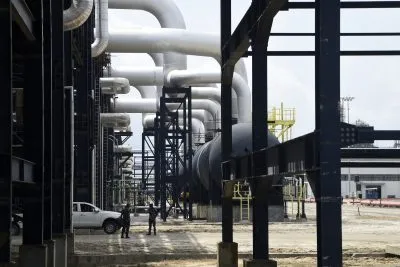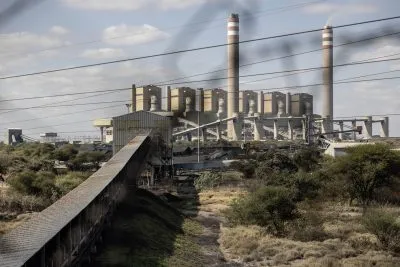GE first started operating in sub-Saharan Africa over 100 years ago, but in 2011, the company decided to renew its focus to meet Africa’s current and future needs. Vuyelwa Mahanyele, regional sales director for GE’s gas business in Southern and East Africa, explains to us why decarbonisation is the overarching theme for both GE and the region and why gas and hydrogen are an important part of the energy mix.
What are GE’s main priorities in the sustainable power space?
I would say decarbonisation is the overarching theme of everything that we do from a power generation perspective. Even within our region we’ve put many megawatts on the ground in the time that I’ve been at GE – I’d say we’re probably the leading OEM in terms of installed base across the region with gas power – but despite these significant efforts to increase access to power in sub-Saharan Africa, irrespective of fuel source, our region still lags behind. There’s a big part of our population that still does not have access to electricity.
You may be familiar with that popular soundbite that trended many years ago, where 1.2bn people in the world do not have access to electricity and half of them live in SSA. That soundbite has not changed much 10 years later, except now it’s 800m people without access to power. And more than half of them are living within our region. At a macroeconomic level, these energy shortages are a massive drag on the economic growth within our region and job creation.
So when we say what our focus is, it can never just be limited to putting megawatts on the ground. We need to have impact that is far bigger than just the power. It’s everything that snowballs from there.
There’s a lot of different understandings of what transition means. Can you talk to us about what that means for GE?
When GE talks about decarbonisation, we take into account the energy trilemma, which is facing every country, and this entails simultaneously balancing affordability, reliability and sustainability.
Depending on the demand of the country, the level of economic development and other factors in each country, the solution to the trilemma will look different. It becomes very tricky to find the balance, when there is such a power deficit within our region, and so as GE we’ve always said that the most effective way to ensure a successful transition is through a power system that is diverse and has a rich mix of generation technologies because there is no silver bullet approach and we really need to stop our preoccupation with a single generation source.
I think in recent years, renewables have taken over the narrative around what power systems need to look like. But when we talk about the energy dilemma, especially in our region, there’s a fourth dimension, which is just as urgent, and that’s the need to leverage these infrastructure projects, creating jobs, developing skills and building industry, to continue to drive growth in our countries.
So it cannot be a case of either/or. We do need sustainable power and we do need to industrialise as well. And I think it’s important that companies like ourselves and other multilateral agencies align to country priorities. I think when a lot of people talk about decarbonisation, it’s renewables, it’s carbon capture, it’s hydrogen, which is all good and well, but you need that and more.
So energy strategies and energy mixes should be centred on actions that are determined locally, based on the resources that are available locally, based on policy that prevails in the country and based on the infrastructure requirements of that country. It obviously becomes challenging to achieve this because we operate in a global community, and developed economies do lot of the funding.
Projects within our region come from these regions and from these multilateral agencies. And so as an organisation, we’re certainly putting forward that gas, in combination with renewables, is the fastest path to net zero.
But renewables is also diverse. There’s hydro there’s solar, there’s when wind, and these all need to be explored to the full breadth where they can add value to the country.
Is gas part of Africa’s long-term energy future?
Gas-fired power is a lower carbon alternative to coal-fired power generation. So for example, a country like South Africa, switching from coal to gas immediately reduces our emissions quite significantly, across our entire fleet.
I am not of the same school of thought that our region needs to walk away from gas. Certainly not at a time when some of the biggest gas reserves are found within our region. Mozambique and Nigeria have them. South Africa recently announced its own reserves. Namibia has recently also announced that they have significant gas reserves that they plan to commercialise.
It’s not just about gas coming into the system for industrial use or power generation. The build out of those projects is significant to changing the economic trajectory of these countries, South Africa included. And so I think there is some way for gas to go. Gas will not disappear immediately and we see gas at GE as a transition fuel.
So as the world transitions from being carbon heavy, gas is that fuel that will lead us to the path of near net zero. I say “near net zero”, because again, we’ll be preoccupied with complete net zero. Even if the energy sector were to completely decarbonise, it still would not eradicate emissions because the power sector’s not the only sector that’s emitting.
So there needs to be a collective effort around key and large industry, on how we decarbonise in a practical and effective manner. The beautiful thing about our turbines is that they can transition from running on natural gas today to hydrogen. And we continue to invest in technology just to ensure that our turbines are enhancing their capability of running on hydrogen.
We are seeing that gas has a role to play in the transition, but alongside renewables. And I think that is really our selling proposition around the decarbonisation narrative, certainly within the South.
What is the global market for hydrogen? How practical is this for Africa? How does it actually work?
Globally, the hydrogen market is growing and I’d say it’s important to separate that just because some countries within our region and others are only in their infancy stage of hydrogen to power.
We have customers in Australia, in Europe, who’ve been running their plants with hydrogen blends since the 90s and this is part of their approach to decarbonisation. In our region it’s countries like South Africa and Namibia who are leading the charge and at a smaller scale.
There’s a rainbow of hydrogen colours. There’s green, there’s black, there’s grey, there’s turquoise. The colour of the hydrogen is informed by the technology used to produce it. Hydrogen that is used from renewable technology will be referred to as green hydrogen.
Let me give you a flavour of how hydrogen is produced. South Africa produces hydrogen today, but not in the large-scale quantities that we need to run a power plant. The sources of grey or black hydrogen are the gasification of coal. Pink hydrogen is electrolysis of water using nuclear.
So it’s a function of the resources you have in country that define the type of hydrogen you produce. And the cost of hydrogen produced by these different methods can obviously vary quite widely. So technically speaking, everyone can do this, but it’s the cost. And the commercial case of what will be done with that hydrogen.
What we’re seeing in South Africa today is the primary sectors or off-takers of that hydrogen are your logistics, transportation, maritime sectors. It’s also being exported, in the agri space, but I think there are ambitions to now have the larger quantities of hydrogen coming into the system to power gas turbines.
We speak about pre- and postcombustion as a way of decarbonising. Precombustion, the most common approach to tackling this is using a cleaner fuel, and the fuel for decarbonisation that everyone is focused on now is hydrogen. Postcombustion is when there are different technologies to remove CO2 and that CO2 is either stored underground or it’s, used in industrial processes. And this is what is now typically known as carbon capture utilisation.
These are all viable options, but some of the drawbacks that we need to talk about is high upfront capex. When you include carbon capture and utilisation (CCU) today, it requires more space. It sometimes reduces the efficiency of the turbine. And so as much as we’re seeing many CCU projects globally, they require either policy incentives or funding mechanisms to enable them because they’re not entirely viable today. But we see that in the near future, 10, 15 years from today, they’ll become a more standard integration in our power mix.
Want to continue reading? Subscribe today.
You've read all your free articles for this month! Subscribe now to enjoy full access to our content.
Digital Monthly
£8.00 / month
Receive full unlimited access to our articles, opinions, podcasts and more.
Digital Yearly
£70.00 / year
Our best value offer - save £26 and gain access to all of our digital content for an entire year!
 Sign in with Google
Sign in with Google 



